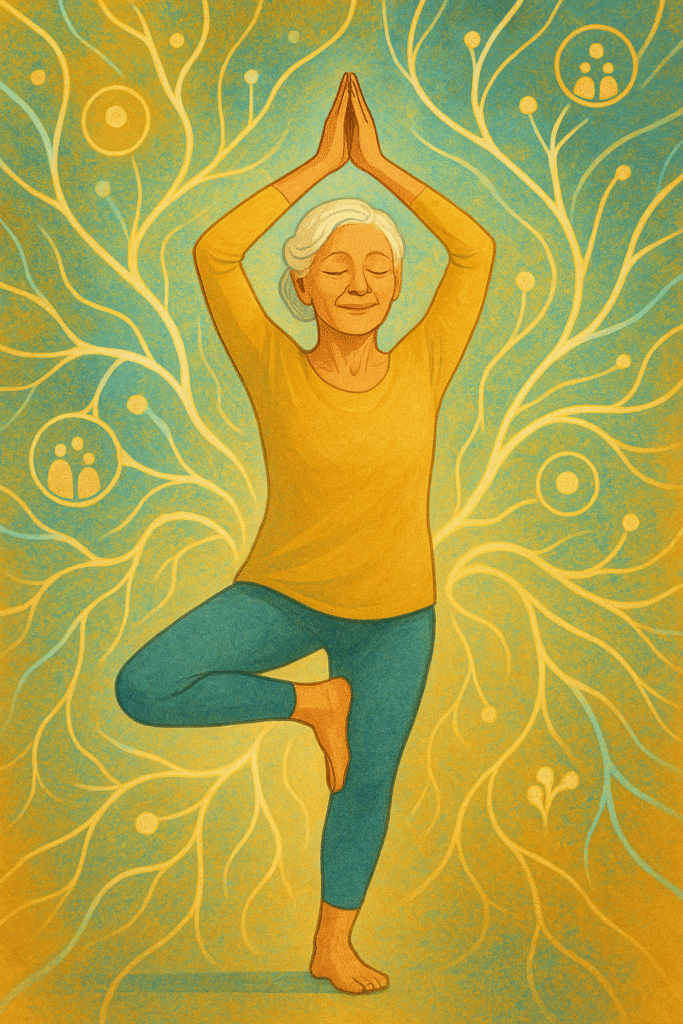
ChatGPT:
The 102-Year-Old Yoga Teacher Who Shows Aging Doesn’t Have to Mean Decline
When you ask Charlotte Chopin, a yoga teacher in the French village of Léré, how she’s still leading classes at 102, she doesn’t give you a TED Talk. No biohacking gadgets, no miracle diet, not even an Instagram reel about her morning routine.
Her answer is simple: she just kept doing yoga.
Charlotte began her practice at age 50, stuck with it for more than half a century, and today she still teaches the same poses she did decades ago. It sounds quaint, but psychology and neuroscience suggest she has stumbled into the science of positive aging.
Why “Same Old” Is Smart
Charlotte’s classes don’t evolve much. “The poses are the poses,” she says. What sounds like stubbornness is actually neurobiological efficiency.
Repetition strengthens neural circuits through Hebbian learning—“neurons that fire together wire together.” By sticking to familiar movements, Charlotte carved highways in her motor cortex, so balance and posture became nearly automatic.
This protects the prefrontal cortex (PFC), the brain’s CEO for planning and decision-making. The PFC is fragile, especially with age. Decision fatigue—burning it out with trivial choices—can accelerate decline. Charlotte’s routine spares her PFC from micromanaging every class. The autopilot poses free her brain to focus on teaching, connecting, and enjoying.
In personality science, this reflects conscientiousness—a trait tied to longevity. Conscientious people keep routines, honor commitments, and avoid risky detours. Charlotte’s discipline wasn’t just aesthetic; it was life insurance disguised as yoga.
The Growth Mindset at Midlife
Charlotte didn’t start yoga young. She began at 50, an age when many declare themselves “too old to learn new tricks.” That choice exemplifies growth mindset—the belief that skills can be developed through effort, not frozen at birth.
Psychologically, growth mindset fuels persistence. Neuroscientifically, it leverages neuroplasticity. Even in midlife, the brain can reorganize and form new connections.
Studies show growth-mindset brains pay more attention to mistakes, seeing them as feedback instead of failure. Charlotte’s early wobbles weren’t signs she’d missed her chance; they were reps in a half-century practice that kept her sharp.
Students as Lifelines
Charlotte often credits her students, not yoga itself, as her biggest source of strength. This reflects socioemotional selectivity theory (SST).
As people age, they become more aware of limited time. According to SST, this shifts priorities: fewer shallow ties, more emotionally meaningful ones. Younger adults chase novelty and networks. Older adults choose depth.
Charlotte’s classroom isn’t just exercise—it’s connection. Neuroscience backs this up: older brains show a “positivity bias,” reacting less to negative social cues and more to positive ones. Add dopamine (reward) and oxytocin (bonding), and meaningful relationships become literal medicine.
Loneliness, by contrast, is one of the strongest predictors of early mortality. Charlotte’s decades of teaching kept her woven into community life, buffered from isolation.
The Gratitude Advantage
On a cabinet in her living room sits a plaque: “Happiness is not about having everything you want, but loving what you have.” That could be the motto of positive psychology.
Instead of focusing only on what’s broken, positive psychology studies what makes life worth living: gratitude, engagement, purpose. Charlotte checks every box.
- Positive emotions: Gratitude calms stress circuits in the brain.
- Engagement: Yoga puts her in flow states—deep absorption in practice.
- Relationships: Her students sustain her daily.
- Meaning: Teaching gives her purpose.
- Accomplishment: Half a century of mastery reinforces confidence.
From neuroscience’s angle, gratitude reduces amygdala reactivity (less fear, stress) and boosts reward pathways. Meaning recruits the prefrontal cortex to stitch together life events into coherent, satisfying narratives. Charlotte isn’t just aging; she’s aging with purpose.
The Upward Spiral of Aging Well
Put it all together and Charlotte’s life forms a self-sustaining cycle:
- Conscientious routines protect the PFC.
- Mastery builds confidence and self-efficacy.
- Growth mindset keeps learning alive.
- Social bonds sustain emotional resilience.
- Gratitude and meaning stabilize mood.
Instead of spiraling into frailty, Charlotte built an upward spiral. Every piece reinforced the next, keeping her active, engaged, and fulfilled long after most peers slowed down.
Lessons for the Rest of Us
Most of us won’t hit 102 while teaching yoga, but Charlotte’s story offers a science-backed blueprint:
- Simplify routines to reduce decision fatigue.
- Embrace growth mindset—plasticity isn’t gone at 70, 80, or 90.
- Prioritize emotionally meaningful relationships over shallow validation.
- Practice gratitude and meaning-making to protect emotional health.
- Keep moving—physically, mentally, socially.
Charlotte never set out to be a guru. She just taught her classes and loved what she had. Yet her life embodies what psychology and neuroscience both say: aging can be not just survivable, but joyful.
Final Thought
The stereotype of aging is decline, loss, and narrowing horizons. Charlotte Chopin’s century-long yoga journey proves another possibility. With the right mix of routine, mindset, connection, and gratitude, aging can be a time of mastery, depth, and flourishing.
The poses may be the same, but the meaning grows richer with time. And maybe that’s the real lesson: bend with life, and it bends with you.
